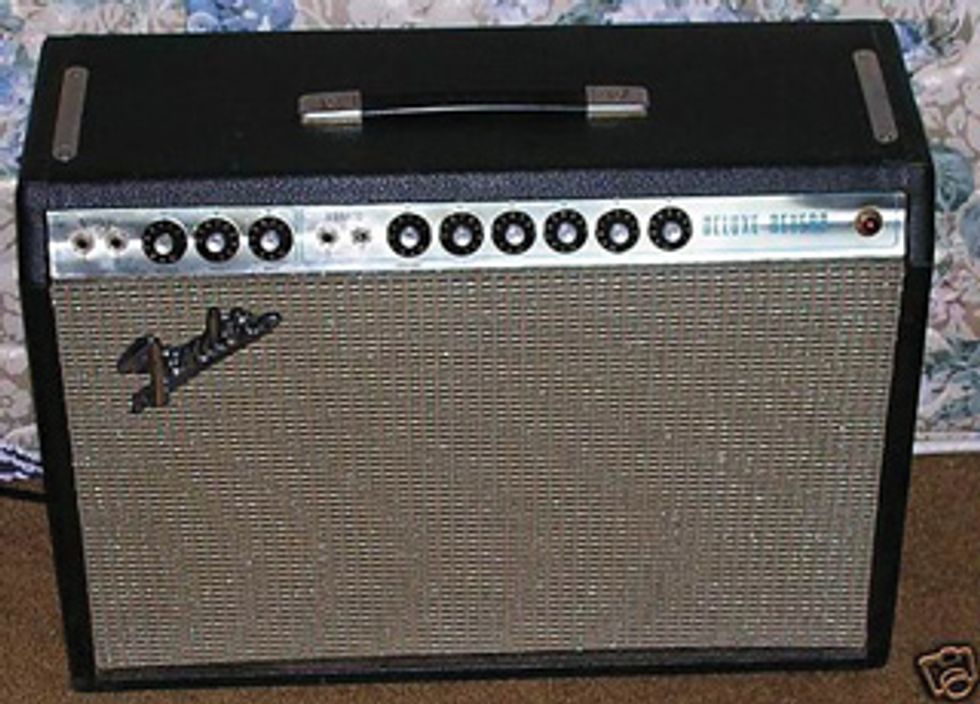Hi Jeff,
I have a 1972 Fender Deluxe Reverb.
It sounds great, so I don’t want to alter
the tone too much. I just want to beef
up the power supply for when the voltages
are high or the amp is really being
worked. I’m curious how much power
filtering is enough to make a tube amp
super-reliable without choking the sound
too dramatically, destroying rectifier
tubes, or causing other ill effects.
The AB868 schematic calls for stock values of the filter caps to be 16 μF 450V, but I’ve read that the microfarad and voltage values can be increased to achieve the aforementioned goal. That said, some contend that an increase in cap value is often accompanied with a mod to a series-wired “totem-pole” stack configuration of the main filters, if the amp doesn’t have one. I’ve heard that this was common on blackface amps, but the Deluxe schematics (both AB763 and AB868) appear to show the two main filters wired in parallel.
So here are my questions: Exactly how
many caps should be replaced in this particular
amp for adequate filtering? Should
I just be concerned with increasing the
values of the main filters, or should the
second-stage filter values be increased as
well? Would a totem-pole stack configuration
in a Deluxe blow the rectifier? Should
the value of the bias supply cap(s) be
increased too? Should I replace all of the
bypass caps on the tubes as well? When
possible, should I remove the boards to
de-solder the leads from the bottom first?
Best,
Tom Swanson
Hi Tom,
Your question about filtering is both interesting
and subjective. In my opinion, the
amount of filtering in each stage of an
amplifier’s power supply is discretionary.
Increasing or decreasing the amount of
filtering in any given section of the power
supply can change the amp’s performance
and response. The result can be an amp
that sounds warmer and feels softer, or
sounds full-bodied and feels tight, or even
sounds cold and sterile. The latter can happen
when you employ too much filtering.
Yes, the amp will likely be less noisy, but is
that worth the compromise in audio performance?
I think not. So with that in mind,
I’ll try to answer your questions.
Your Deluxe Reverb’s power supply has four sections—A, B, C, and D. Section A is where the initial filtering of the DC voltage occurs. In its stock configuration, there are two 16 μF 450V capacitors in parallel, resulting in a total capacitance of 32 μF. This usually works well enough in a Deluxe Reverb-style circuit, but if you want to have a little more reserve in the power supply, you could start by replacing the two 16 μF capacitors with two 22 μF caps. This would yield 44 μF of filtering, which is an increase of approximately 37 percent.
At this point, the amp may be marginally quieter and stay a bit tighter when pushed hard. Theoretically, the maximum capacitance load on a 5U4 rectifier tube is 40 μF, but I’ve not seen where 44 μF has caused a problem for any decent rectifier. But I’d caution against going much higher, as this might affect the 5U4’s reliability.
You might consider using a 5AR4 rectifier, as this would increase the high voltage in the amp a bit. Increasing the voltage would marginally increase the output power and help the amp remain cleaner at higher volume levels. You could also increase the amount of filtering in the power supply, as the maximum capacitance load on a 5AR4 is stated as 60 μF. To achieve that, you could install two 30 μF caps, or a 47 μF and a 16 μF, for a total of 63 μF. It would be fine to mix and match here, as these caps are in parallel and the total value is additive, as opposed to a “totem-pole” style filter.
In a totem pole, two identical caps are placed in series and the total capacitance is half the value of the caps. For example, the two 70 μF caps in a blackface Twin Reverb: The total value of this section of the power supply is only 35 μF. However, this is done to increase the voltage rating of this section of filtering. Using two 70 μF 350V DC caps yields a filter section with a maximum voltage rating of 700V. This is generally more cost-effective than using a 600V cap in some amps where voltages could approach 500 volts. This is unnecessary in your Deluxe—even equipped with a 5AR4—as the voltages would not reach 500V. But I do recommend that you use capacitors with voltage ratings of at least 475V DC.
Regarding the caps in the B, C, and D sections of the power supply, I’d keep the stock 16 μF values. If you do increase them, I’d advise 20 μF or 22 μF at most, as larger values would begin to substantially change the amp’s sound and feel.
Regarding the filter cap in the bias supply: As long as you’re modding, why not replace this cap? The stock value is 50 μF 70V DC, but I’d recommend a 100 μF 100V DC cap. Even though the main power supply filtering affects overall hum level in the amp’s noise floor, a dirty bias supply can also contribute to noise, so a clean bias voltage can help.
As far as the bypass caps across all the preamp tube cathode resistors, unless one has become noisy this doesn’t really make the amp quieter or keep it tighter at high volumes. Actually, increasing values here can cause things to “muddy up” more at high volumes, so I’d leave these alone.
And lastly, there’s no need to remove the boards prior to replacing the capacitors. The eyelet boards in Fender amps are super reliable, and you’re unlikely to damage one with standard soldering techniques.
Warning: All tube amplifiers contain lethal voltages. The most dangerous voltages are stored in electrolytic capacitors, even after the amp has been unplugged from the wall. Before you touch anything inside the amp chassis, it’s imperative that these capacitors are discharged. If you are unsure of this procedure, consult your local amp tech.
 Jeff Bober is one of
the godfathers of the
low-wattage amp revolution,
co-founded and was
the principal designer for
Budda Amplification. Jeff recently launched EAST
Amplification, and he can be reached at
pgampman@gmail.com.
Jeff Bober is one of
the godfathers of the
low-wattage amp revolution,
co-founded and was
the principal designer for
Budda Amplification. Jeff recently launched EAST
Amplification, and he can be reached at
pgampman@gmail.com.







![Rig Rundown: Russian Circles’ Mike Sullivan [2025]](https://www.premierguitar.com/media-library/youtube.jpg?id=62303631&width=1245&height=700&quality=70&coordinates=0%2C0%2C0%2C0)


























